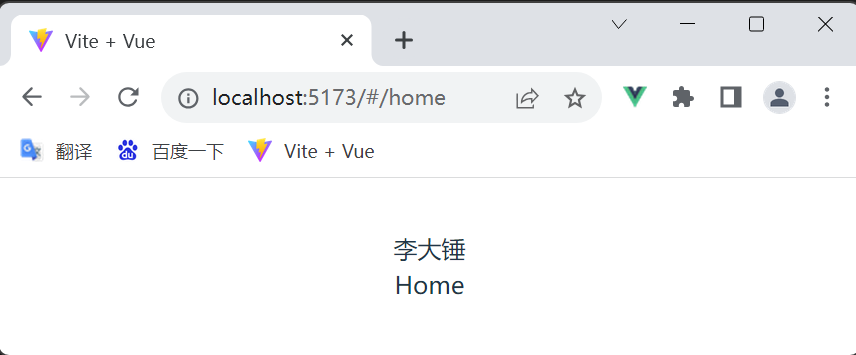简介
Vue Router 是 Vue.js 的官方路由。它与 Vue.js 核心深度集成,让用 Vue.js 构建单页应用变得轻而易举。功能包括:
- 嵌套路由映射
- 动态路由选择
- 模块化、基于组件的路由配置
- 路由参数、查询、通配符
- 展示由 Vue.js 的过渡系统提供的过渡效果
- 细致的导航控制
- 自动激活 CSS 类的链接
- HTML5 history 模式或 hash 模式
- 可定制的滚动行为
- URL 的正确编码
路由的基本使用
用 Vue + Vue Router 创建单页应用非常简单:通过 Vue.js,我们已经用组件组成了我们的应用。当加入 Vue Router 时,我们需要做的就是将我们的组件映射到路由上,让 Vue Router 知道在哪里渲染它们。
Unpkg.com 提供了基于 npm 的 CDN 链接。上述链接将始终指向 npm 上的最新版本。 你也可以通过像 https://unpkg.com/vue-router@4.0.15/dist/vue-router.global.js 这样的 URL 来使用特定的版本或 Tag。
安装 vue router
npm install vue-router@4
#或者
yarn add vue-router@4
使用案列
在项目中的src文件夹下面创建一个router的文件夹和一个views文件夹
在router文件夹下面创建一个index.js文件
在views文件夹下面创建一个Home.vue组件和一个List.vue组件
index.js文件内容:
import { createRouter,createWebHashHistory,createWebHistory } from "vue-router"; //导入vue-router路由模块,createWebHashHistor函数
import Home from "../views/Home.vue" //导入Home组件
import List from "../views/List.vue"
const routes = [
{
path: "/", //路径:
//component: List //path路径所对应的组件
//表示如果路径是/ 那么就跳转到/list路径,而/list路径对应的是List组件,所以就显示出List组件的内容了
//举列:当浏览器输入的是:http://localhost:5173/ 则会重定向跳转到 http://localhost:5173/#/list
redirect:"/list"
},
{
path: "/home", //路径
component: Home //path路径所对应的组件:路径/ 和/home 都可以路由到Home组件
},
{
path: "/list", //路径
component: List //path路径所对应的组件
}
]
//创建路由对象
const router = createRouter({
//history:createWebHashHistory() 这种方式是按照hash路由模式来路由导航,这种路由模式的url地址会存在 /#/ 样式是:http://localhost:5173/#/list
history: createWebHistory(), //这种方式基于浏览器 history API 的路由模式,url的样式是:http://localhost:5173/list
routes, //routes:routes的缩写
})
export default router //导出router路由对象//导出router路由对象
// createWebHashHistory() 是 Vue Router 提供的一种基于浏览器 URL 的 hash 路由模式,它将路由添加到 URL 中的 hash 中
// 例如:/#/home、/#/about。这种模式可以避免服务器配置的问题,而且支持所有浏览器。
// 但是,由于 URL 中添加了 hash,因此在搜索引擎的 SEO 优化中存在一些问题。main.js文件内容
import { createApp } from 'vue'
import './style.css'
import App from './App.vue'
//import router from "../src/router" //导入路由js 注意:如果仅仅是指定了一个文件夹router,程序会自动去router文件夹下寻找index.js,并导入
//import router from "../src/router/index" //导入路由js 注意:.js可以省略
import router from "../src/router/index.js" //导入路由js
//import router from "../src/router/myindex.js" //导入路由js 注意:如果我们的路由文件不是index.js 那么我们就得指定具体的名称了
var app=createApp(App)
app.use(router) //注册路由组件
app.mount("#app")App.vue组件
<template>
<div>
{{ name }}
<!-- <RouterView></RouterView> 是 Vue.js 框架中的一个组件,用于渲染与当前路由匹配的组件视图。当用户在应用中导航到不同的页面时,<RouterView> 组件会负责显示与当前路由对应的组件。 -->
<!-- 举列:如果浏览器中输入:http://localhost:5173/#/list 这个路径对应的组件list就会插入到<RouterView></RouterView>中 -->
<router-view></router-view>
</div>
</template>
<script setup>
import { ref, } from 'vue';
//导入模板即注册:注册的名字就是你导入用的名称Home
import Home from "./views/Home.vue" //导入Home组件:
import List from "./views/List.vue" //导入List组件:
const name = ref("李大锤");
</script>
Home.vue组件
<template>
<div>Home</div>
</template>List.vue组件
<template>
<div>List</div>
</template>路由的懒加载
懒加载的作用是:打开页面就不会加载所有的组件,而是根据当前页面需要的组件进行加载
用法:
component: () => import("../views/Home.vue")案列
index.js路由文件
import { createRouter, createWebHashHistory,createWebHistory } from "vue-router"; //导入vue-router路由模块,createWebHashHistor函数
//import Home from "../views/Home.vue" //异步加载的组件,这里不需要
//import List from "../views/List.vue" //异步加载的组件,这里不需要进行导入,所以要注释掉
const routes = [
{
path: "/", //路径:
redirect: {
name: "mylist" //重定向到路由名称为mylist的路由中,这样当浏览器输入的是:http://localhost:5173/ 则会重定向跳转到 http://localhost:5173/list
}
},
{
path: "/home", //路径
//当路由被触发时,该组件才会被异步加载,举列:打开页面就不会加载所有的组件,而是根据当前页面需要的组件进行异步加载
//这样可以减少初始加载时间,提升用户体验,同时也节省了不必要的资源消耗。
component: () => import("../views/Home.vue")
},
{
path: "/list", //路径
name: "mylist", //路由名称,如果不指定name 默认的name为default
//当路由被触发时,该组件才会被异步加载,举列:打开页面就不会加载所有的组件,而是根据当前页面需要的组件进行异步加载
//这样可以减少初始加载时间,提升用户体验,同时也节省了不必要的资源消耗。
component: () => import("../views/List.vue")
}
]
//创建路由对象
const router = createRouter({
//history:createWebHashHistory() 这种方式是按照hash路由模式来路由导航,这种路由模式的url地址会存在 /#/ 样式是:http://localhost:5173/#/list
history: createWebHistory(), //这种方式基于浏览器 history API 的路由模式,url的样式是:http://localhost:5173/list
routes, //routes:routes的缩写
})
export default router //导出router路由对象//导出router路由对象路由别名的使用
在单页面应用中,网页具体路径显示是由vue-router配置中 path 决定的,path设置的是什么就显示什么,和name无关。
不同路由路径下页面渲染的内容,是根据component所对应的组件来进行渲染的,和name无关。
其实name就相当于给你的path取个别名,方便使用,路由并不是一定要设置name值。(如果不设置name,vue-router默认name值为 default)
index.js文件内容:
import { createRouter,createWebHashHistory } from "vue-router"; //导入vue-router路由模块,createWebHashHistor函数
import Home from "../views/Home.vue" //导入Home组件
import List from "../views/List.vue"
const routes = [
{
path: "/", //路径:
//component: Home //path路径所对应的组件
//表示如果路径是/ 那么就跳转到/list路径,而/list路径对应的是List组件,所以就显示出List组件的内容了
//举列:当浏览器输入的是:http://localhost:5173/ 则会重定向跳转到 http://localhost:5173/#/list
//redirect:"/list"
//redirect:"/list" 这种重定向是使用的路径方式来重定向的。我们也可以通过路由的name来重定向,如下:
redirect:{
name:"mylist" //重定向到路由名称为mylist的路由中,这样当浏览器输入的是:http://localhost:5173/ 则会重定向跳转到 http://localhost:5173/#/list
}
},
{
path: "/home", //路径
component: Home //path路径所对应的组件:路径/ 和/home 都可以路由到Home组件
},
{
path: "/list", //路径
name:"mylist", //路由名称,如果不指定name 默认的name为default
component: List //path路径所对应的组件
}
]
//创建路由对象
const router = createRouter({
history: createWebHashHistory(),//按照hash路由模式来路由导航,这种模式的url地址会存在 /#/
routes, //routes:routes的缩写
})
export default router //导出router路由对象//导出router路由对象
嵌套路由:子级路由
就是父路由嵌套子路由.url 上就是/list 嵌套两个子路由后就是/list/lista 和/list/listb
就拿上面的使用案列来说:
| 路径 | 组件 |
|---|---|
| /list | List |
| /list/lista | ListA |
| /list/listb | ListB |

List.vue组件
<template>
<div>
<ul class="tabbar">
<router-link custom to="/list/lista" v-slot="{ isActive, navigate }">
<li :class="isActive ? 'aaa' : ''" @click="navigate">正在热映</li>
</router-link>
<router-link custom to="/list/listb" v-slot="{ isActive, navigate }">
<li :class="isActive ? 'aaa' : ''" @click="navigate">即将上映</li>
</router-link>
</ul>
<!-- <router-link to="/list/lista">正在热映</router-link>
<router-link to="/list/listb">即将上映</router-link> -->
</div>
<div>
<router-view></router-view>
</div>
</template>
<script setup>
import ListA from './ListA.vue';
import ListB from './ListB.vue';
</script>
<style scoped>
ul {
display: flex;
position: fixed;
/* bottom: 0; 元素在页面底部*/
/* top: 0; 元素在页面顶部 */
top: 0;
width: 100%;
height: 50px;
line-height: 50px;
list-style-type: none;
justify-content: space-between;
}
li {
flex: 1;
text-align:left;
}
.aaa {
color: red;
}
div {
display: flex;
width: 100%;
justify-content: space-between;
height: 50px;
line-height: 50px;
/* background: gray; */
}
</style>
ListA.vue组件
<template>
<div>ListA</div>
</template>ListB.vue组件
<template>
<div>ListA</div>
</template>index.js路由文件内容
import { createRouter, createWebHashHistory } from "vue-router"; //导入vue-router路由模块,createWebHashHistor函数
import Home from "../views/Home.vue" //导入Home组件
import List from "../views/List.vue"
import ListA from "../views/ListA.vue"
import ListB from "../views/ListB.vue"
const routes = [
{
path: "/", //路径:
//component: Home //path路径所对应的组件
//表示如果路径是/ 那么就跳转到/list路径,而/list路径对应的是List组件,所以就显示出List组件的内容了
//举列:当浏览器输入的是:http://localhost:5173/ 则会重定向跳转到 http://localhost:5173/#/list
//redirect:"/list"
//redirect:"/list" 这种重定向是使用的路径方式来重定向的。我们也可以通过路由的name来重定向,如下:
redirect: {
name: "mylist" //重定向到路由名称为mylist的路由中,这样当浏览器输入的是:http://localhost:5173/ 则会重定向跳转到 http://localhost:5173/#/list
}
},
{
path: "/home", //路径
component: Home //path路径所对应的组件:路径/ 和/home 都可以路由到Home组件
},
{
path: "/list", //路径
name: "mylist", //路由名称,如果不指定name 默认的name为default
component: List, //path路径所对应的组件
children: [ //通过children配置子级路由
{
path: 'lista', //可以写成:'/list/lista' 但是不要写成 '/lista'
component: ListA
},
{
path: 'listb',//可以写成:'/list/listb' 但是不要写成 '/listb'
component: ListB
}
]
}
]
//创建路由对象
const router = createRouter({
history: createWebHashHistory(),//按照hash路由模式来路由导航,这种模式的url地址会存在 /#/
routes, //routes:routes的缩写
})
export default router //导出router路由对象//导出router路由对象
路由案列+路由拦截
index.js路由
import { createRouter, createWebHistory } from "vue-router"; //导入vue-router路由模块,createWebHashHistor函数
const routes = [
{
path: "/", //路径:
redirect: "/Films" //涉及到多级页面跳转需要用路径的跳转,不能用name的跳转; 浏览器进入http://localhost:5173/ 首先要跳转的路径是/Films,即:要跳转到http://localhost:5173/Films,而进入http://localhost:5173/Films后又发现/Films要重定向到/Films/NowPlaying,这样就实现了打开http://localhost:5173/就加载出来了http://localhost:5173/Films/NowPlaying内容
// redirect: {
// name: "Films" //重定向到路由名称为Tabbar的路由中,这样当浏览器输入的是:http://localhost:5173/ 则会重定向跳转到 http://localhost:5173/Films
// }
},
{
path: "/Navbar", //路径:导航栏
name: "Navbar",
//当路由被触发时,该组件才会被异步加载,举列:打开页面就不会加载所有的组件,而是根据当前页面需要的组件进行异步加载
//这样可以减少初始加载时间,提升用户体验,同时也节省了不必要的资源消耗。
component: () => import("../views/Navbar.vue")
},
{
path: "/FilmsDetail/:myid/:myname", //路径:电影内容详细 "/FilmsDetail/:myid"的意思是:当路由以/FilmsDetail/为开头那么它后面的就是myid参数:举列:http://localhost:5173/FilmsDetail/123 那么这个123就是myid参数; 如果存在两个参数呢?"/FilmsDetail/:myid/:myname" 举列:http://localhost:5173/FilmsDetail/123/lily 那么这个123就是myid参数,lily就是myname参数
name: "FilmsDetail", //路由名称,如果不指定name 默认的name为default
//当路由被触发时,该组件才会被异步加载,举列:打开页面就不会加载所有的组件,而是根据当前页面需要的组件进行异步加载
//这样可以减少初始加载时间,提升用户体验,同时也节省了不必要的资源消耗。
component: () => import("../views/FilmsDetail.vue")
},
{
path: "/Tabbar", //路径:底部选项卡
name: "Tabbar", //路由名称,如果不指定name 默认的name为default
//当路由被触发时,该组件才会被异步加载,举列:打开页面就不会加载所有的组件,而是根据当前页面需要的组件进行异步加载
//这样可以减少初始加载时间,提升用户体验,同时也节省了不必要的资源消耗。
component: () => import("../views/Tabbar.vue"),
},
{
path: "/Films", //路径:电影
name: "Films", //路由名称,如果不指定name 默认的name为default
//当路由被触发时,该组件才会被异步加载,举列:打开页面就不会加载所有的组件,而是根据当前页面需要的组件进行异步加载
//这样可以减少初始加载时间,提升用户体验,同时也节省了不必要的资源消耗。
component: () => import("../views/Films.vue"),
children: [ //通过children配置子级路由
{
path: 'NowPlaying', //可以写成:'/Films/NowPlaying' 但是不要写成 '/NowPlaying'(正在热映)
name: "NowPlaying",
component: () => import("../views/NowPlaying.vue")
},
{
path: 'ComingSoon', //可以写成:'/Films/ComingSoon' 但是不要写成 '/ComingSoon'(即将上映)
component: () => import("../views/ComingSoon.vue")
},
{
//为什么在子路由中添加一个Films路由?:答:因为在进入Films组件后就需要立即加载NowPlaying组件的内容。:注意:这里需要加斜杆/Films ;
//从app.vue组件中进入Films组件的时候,跳转的地址是:http://localhost:5173/Films,这时候就找到了顶级路由/Films,到然进入子级路由children,发现了后/Films需要跳转到/Films/NowPlaying
path: '/Films',
redirect: "/Films/NowPlaying"
},
]
},
{
path: "/Cinemas", //路径:影院
name: "Cinemas", //路由名称,如果不指定name 默认的name为default
//当路由被触发时,该组件才会被异步加载,举列:打开页面就不会加载所有的组件,而是根据当前页面需要的组件进行异步加载
//这样可以减少初始加载时间,提升用户体验,同时也节省了不必要的资源消耗。
component: () => import("../views/Cinemas.vue")
},
{
path: "/Home", //路径:我的
name: "Home", //路由名称,如果不指定name 默认的name为default
//当路由被触发时,该组件才会被异步加载,举列:打开页面就不会加载所有的组件,而是根据当前页面需要的组件进行异步加载
//这样可以减少初始加载时间,提升用户体验,同时也节省了不必要的资源消耗。
component: () => import("../views/Home.vue"),
meta: //加一个自定义参数:里面的参数随便我们定
{
requireAuth: true, // 对当前路由路径做一个标记,代表进入这个页面需要登陆才能进。用于在router.beforeEach里面做登陆验证的时候,判断这个requireAuth参数是否为true,为true则需要登陆才能进入
aaa: "wowow"
}
},
{
path: "/Login", //登陆
name: "Login", //路由名称,如果不指定name 默认的name为default
component: () => import("../views/Login.vue"),
},
{
path: "/:pathMatch(.*)", //404错误
name: "NotFound", //路由名称,如果不指定name 默认的name为default
component: () => import("../views/NotFound.vue")
}
]
//创建路由对象
const router = createRouter({
history: createWebHistory(), //这种方式基于浏览器 history API 的路由模式,url的样式是:http://localhost:5173/list
routes: routes,
})
//路由全局拦截:在进入页面之前就进行拦截。可以用于做用户登陆验证
//参数to: 表示即将进入的目标路由对象
//参数from:表示当前导航正要离开的路由
//参数next:调用该方法后才能进入下一个钩子。next() 直接进入下一个钩子,next(false) 中断当前的导航。next('/') 或者 next({ path: '/' }) 则会进入一个不同的地址。
router.beforeEach(async (to, from, next) => {
const isAuthenticated = await localStorage.getItem('token');
console.log(to.fullPath); //全路径
console.log(to.path); //路径
console.log(to.name); //路由名称
console.log(to.params); //路由参数:http://localhost:5173/FilmsDetail/123
console.log(to.query); //路由参数:http://localhost:5173/FilmsDetail?myid=123
console.log(to.meta); //路由自定义参数
//meta.requireAuth表示当前请求的页面需要验证, 并且未登录
if (to.meta.requireAuth && !isAuthenticated) {
next(`/login?redirect=${to.path}`) //to.fullPath
}
else next() //如果不是请求的登陆界面,或者已经登陆过了,则直接跳转到用户请求的界面
})
//路由全局拦截:在进入页面之后才进行触发拦截。
router.afterEach(async (to, form) => {
//用的比较少,一般用于收集一些日志信息,做用户行为分析:例如:收集页面浏览量:PV
})
export default router //导出router路由对象//导出router路由对象





















 1881
1881











 被折叠的 条评论
为什么被折叠?
被折叠的 条评论
为什么被折叠?








